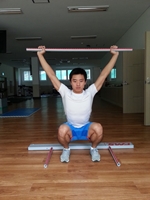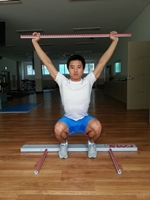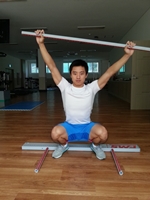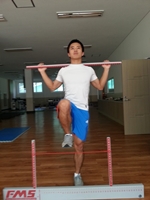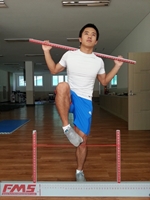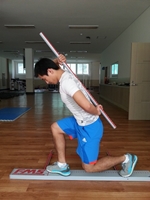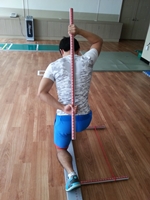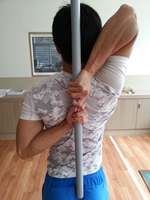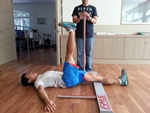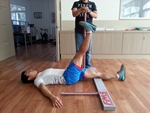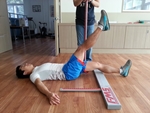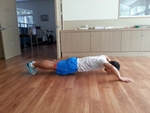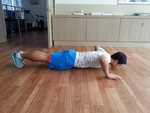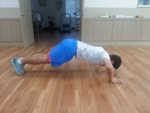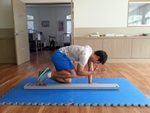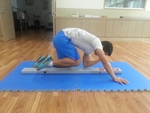고등학교 야구선수의 손상 예방을 위한 16주간 기능성 움직임 개선 훈련 프로그램 적용이 기능성 움직임 검사(FMSTM) 점수 변화에 미치는 영향
Effect of 16-week functional movement improvement training program for injury prevention on Functional Movement Screen (FMSTM) test score in high-school baseball players
Article information
Abstract
본 연구의 목적은 고등학교 야구선수를 대상으로 기능성 움직임 개선 훈련 프로그램이 기능성 움직임 검사 점수 변화에 미치는 효과를 검증하는 데 있었다. 연구대상자를 훈련군 35명(training Group: TG)과 대조군 42명(control Group: CG)으로 분류한 뒤, 시즌 중 16주 동안의 훈련 프로그램 적용 전후 기능성 움직임 검사 점수 변화를 살펴본 결과, TG에서는 Deep Squat, Hurdle Step, In-Line Lunge, Shoulder Mobility, Active Staight Leg Raise, Rotary Stability 측정항목 및 총점수가 유의하게 향상된 반면, CG의 점수 변화는 유의하지 않았다. 또한, 손상 가능성 기준이 되는 총점수 14점 이하의 인원도 TG에서만 유의하게 감소하였다. 본 연구 결과, 기능성 움직임 개선 훈련 프로그램의 적용은 고등학교 야구선수의 손상 예방에 기여할 수 있을 것으로 사료된다.
Trans Abstract
The purpose of this study was to examine the effect of the functional movement improvement training program on the score of high-school baseball players’ functional movement screen (FMSTM) test. After 16-weeks treatment period, a significant increase of Deep Squat, Hurdle Step, In-Line Lunge, Shoulder Mobility, Active Straight Leg Raise, Rotary Stability, and total score was found only in treatment group. There was decrease on the number of players in treatment group whose total score is less than 14; the criteria vulnerable being injured. The results of this study suggested that applying functional movement improvement training program on high-school baseball players can be effective to prevent injuries.
서론
스포츠에서 경도 손상이 반복적으로 일어나게 되면 만성 손상으로 진행되며, 이것은 경기력 저하뿐만 아니라 선수생활을 조기에 마감하는 결과를 초래하기도 한다(Fuller & Hawkins, 1997). 그래서 많은 운동과학자와 트레이너에 의해 손상 예방과 체력 강화를 위한 체간 안정성(stability)과 관절 가동성(mobility) 훈련의 중요성이 알려져 왔다(Liebenson, 2006; Norris, 1999, 2001).
체간 안정성과 관절 가동성은 근력, 근지구력, 스피드, 파워와 민첩성, 유연성 등과 관련성이 있는 것으로 보고되었다(Jones & Knapik, 1999; Knapik et al., 2001; McHugh & Cosgrave, 2010). 반대로 수동적 관절가동범위(Zebis et al., 2009), 운동 패턴(Van Dillen et al., 2008), 코어(core) 안정성 및 고유감각수용기(Zazulak et al., 2007) 등의 기능 이상은 손상을 유발시킨다고 보고되었다.
이러한 손상을 예방하기 위해 개발된 기능성 움직임 검사(Functional Movement Screen: FMSTM)는 7가지 기본적인 움직임 패턴을 평가하는 도구로써 고유감각수용기, 가동성, 안정성에 기초를 두고 좌·우 불균형과 동작의 제한 등의 기능적 동작의 결함을 간편하게 평가할 수 있는 측정방법이다(Cook et al., 2006a, 2006b). 몇몇의 연구에 의하면 FMSTM로 평가된 총점수는 운동선수의 손상과 유의한 관련성이 있다고 보고되었다(Chorba et al., 2010; Kiesel et al., 2007).
Kiesel 등(2007)은 미식축구 선수 46명을 대상으로 비시즌기에 FMSTM를 통하여 손상의 위험을 확인한 결과, 14점보다 아래의 점수를 획득한 운동선수들에게 기능적으로 감소된 움직임을 보였으며, FMSTM 점수가 높게 나타난 선수들에 비해 손상이 높았다고 보고하였다. Chorba 등(2010)도 여자 대학 운동선수를 대상으로 FMSTM를 진행했을 때, 기존의 연구(Kiesel et al., 2009)에서 제시한 바와 같이 14점 이하로 나타난 운동선수는 하지 손상의 위험이 4배로 증가한다고 보고하였다. 이와 같이 FMSTM 점수에 대한 절대 기준은 손상에 대한 위험을 정량적으로 평가함으로써 손상 예방을 위해 활용할 수 있는 하나의 기준으로 제시되었다.
현재까지의 스포츠 손상 예방 프로그램은 주로 대퇴이두근(Matt & John, 2008), 고유감각수용기(McLeod et al., 2009; Pánics et al., 2008; Zazulak et al., 2008) 등 특정 부위나 신경 등의 적응에 초점이 맞추어져 있었다. 그러나 Cook 등(2010)은 FMSTM를 통해 운동선수가 갖고 있는 임상적 문제점을 특정 부위나 신경 등이 아닌 전신의 움직임을 통해 찾아낸 뒤 해결할 수 있는 기능성 움직임 개선 훈련 프로그램의 기본 전략을 제시한 바 있으며, 이러한 전략을 토대로 만들어진 훈련 프로그램은 FMSTM 총점수를 향상시킨 것으로 보고되었다(Kiesel et al., 2011). 그러나 운동선수를 대상으로 진행된 기능성 움직임 개선 훈련 프로그램에 대한 연구는 부족한 실정이다.
야구는 대표적으로 피칭(pitching)과 스윙(swing) 동작이 반복적으로 수행되며, 강력한 회전력을 요구하는 동작의 특성으로 인하여 손상에 취약한 스포츠이다(Nicholls et al., 2004). Oliver & Weimar(2014)에 의하면 투수의 피칭은 상지와 하지의 조정력이 요구되는 전신 움직임이고 제한된 관절가동범위는 손상에 취약해질 수 있다고 하였으며, Kibler 등(2013)과 Laudner et al.(2010) 또한 불충분한 고관절의 관절가동범위는 피칭 역학을 방해한다고 하였다.
김용권과 김동문(2012)의 야구선수 손상 분석에 의하면 유소년 야구선수의 경우 골격의 미성숙이나 잘못된 자세로 인하여 주관절 손상이 빈번하다고 하였으며, 주관절과 어깨 관절의 손상을 감소시킬 수 있는 예방 운동 프로그램이 필요하다고 언급한 바 있다. 이외에도 야구선수에게 나타나는 복부 근육 좌상(strain)과 같은 손상을 예방하기 위한 방법으로 체간의 안정성을 향상시키는 코어 운동 프로그램을 제시하기도 하였다(Conte et al., 2012).
따라서 본 연구는 고등학교 야구선수를 대상으로 기능성 움직임 개선 훈련 프로그램을 개발하고 적용하여 FMSTM 점수 변화에 미치는 영향을 살펴보고자 하였다.
연구 방법
연구 대상
본 연구는 고등학교 남자 야구선수 총 77명을 대상으로 진행되었다. 훈련군(training group: TG)은 35명, 대조군(control group: CG)은 42명으로 각각 구성되었다. 연구대상자의 야구경력은 두 집단 모두 평균 6.7년으로 동일하였으며, 투수, 포수, 외야수, 내야수 등 모든 포지션이 연구에 참여하였다.
사후 측정에서는 청소년 국가대표 선발, 부상, 전학 등으로 인해 62명(TG: 31명, CG: 31명)만이 참여하였다. 연구 대상자의 신체적 특성은 <표 1>에 제시되었으며, 생체전기저항분석기(Inbody 3.0, Biospace, Korea)를 이용하여 체중을 측정하였다.
측정항목 및 방법
FMSTM
FMSTM는 Deep Squat, Hurdle Step, In-Line Lunge, Shoulder Mobility, Active Straight Leg Raise, Trunk Stability Push-Up, 그리고 Rotary Stability의 7가지 항목을 측정하였다(Cook et al., 2006a, 2006b). FMSTM 측정에 있어서 각 동작의 완성도에 따라 1~3점까지 점수를 부여하였으며, 근육을 수축하거나 동작을 수행할 때, 통증을 호소하는 경우 0점을 부여하였다(Cook et al., 2006a, 2006b; Schneiders et al., 2011). <표 2>에 제시된 FMSTM 측정 항목 중 하나인 In-Line Lunge에서 1점은 보드에서 동작 수행 중 균형을 잃게 된 경우에 부여하였다. 각 측정 항목별 채점 기준에 대해서는 <표 3>에 제시하였다.

FMSTM 측정 항목별 채점 기준(Cook et al., 2006a, 2006b; Frost et al., 2012)
이 연구에서 FMSTM를 측정하기 위하여 재활의학전공의, 운동생리학, 스포츠의학 전문가 3명이 참여하였다. FMSTM 측정의 정확도를 높이기 위하여 공통된 측정 방법을 교재와 동영상을 통해 사전에 교육받았으며, 신뢰성 확보 및 자료의 보존을 위하여 카메라 2대를 연구대상자의 전면과 측면에 위치시킨 뒤 동시에 촬영하였다. 이후 촬영된 영상은 3명의 전문가에게 배포되었으며, 각자 독립된 공간에서 FMSTM 점수 기준에 근거하여 동작에 점수를 부여하였다. 이후 3명의 전문가가 다시 모여 각각의 연구 대상자에게 부여된 FMSTM 점수에 대해 회의를 하였으며, 일치하지 않는 점수가 있는 경우에는 영상과 측정기준 등을 재검토 한 뒤 FMSTM 측정 항목별 채점 기준에 근거하여 수정하였다. 그리고 3명의 전문가에 의해 실시된 FMSTM 측정과 점수 부여를 검토하기 위하여 측정자 간 신뢰도 검사(intraclass correlation coefficient: ICC)를 실시하였으며, 신뢰도는 Fleiss(1986)가 제시한 기준에 근거하였다(기준: >.75는 아주 훌륭한 신뢰도). FMSTM 측정 항목별로 측정자 간 신뢰도 검사를 한 결과, 평균 .73으로 산출되어 높은 신뢰도를 나타냈다.
기능성 움직임 개선 훈련 프로그램 적용
이 연구에서 적용된 기능성 움직임 개선 훈련 프로그램은 FMSTM 관련 문헌들에 제시된 훈련 프로그램(Cook et al., 2010; Kiesel et al., 2011; Peate et al., 2007)과 야구선수를 위한 손상 예방 관련 문헌(Frederick & Frederick, 2006; Goldenberg & Twist, 2006; Kovacs, 2009; National Academy of Sports Medicine, 2010; Osar, 2012; Page et al., 2009; Verstegen & Williams, 2005)을 토대로 재구성하였다.
기능성 움직임 개선 훈련 프로그램은 실내 트레이닝 장에서 오후 훈련 전에 60분, 3회/주, 16주간 실시하였다(Kraemer & Fleck, 2007). 훈련 프로그램에 포함된 운동 동작 시범 및 설명을 위해 훈련 프로그램 적용 전에 연구대상자를 상대로 오리엔테이션을 진행하였다. 모든 연구대상자에게 훈련 프로그램 문서를 나눠줬으며, 문서에는 운동 동작에 대한 사진과 프로토콜 등이 포함되었다.
기능성 움직임 개선 훈련 프로그램은 크게 도입(4주)과 향상 및 유지단계(12주)로 구분하여 적용하였다. 도입 단계에서는 연구대상자가 훈련 프로그램의 내용과 동작에 적응할 수 있도록 하였으며, 4주 후에 세트 수, 그리고 시간 또는 반복횟수 등을 증가시켜 향상 및 유지단계에서 12주간 적용하였다. 모든 훈련 프로그램이 적용된 16주간, 4주마다 자가 직접 실내 트레이닝장을 방문하여 연구대상자의 훈련을 관찰하였다. 기능성 움직임 개선 훈련 프로그램의 자세한 내용과 프로토콜은 <표 4>에 제시하였다.
자료처리 방법
본 연구에서 얻어진 모든 결과는 Window용 SPSS Ver 18.0 통계 프로그램(SPSS, Chicago, IL, USA)을 이용하여 평균(mean) 및 표준편차(standard deviation: SD)를 산출하였다.
기능성 움직임 개선 훈련 프로그램 적용 후 집단 간 FMSTM 측정 항목별 및 총점수 변화에 대한 차이를 검증하기 위해 반복측정 이원변량분석(two-way repeated measure ANOVA)을 실시하였다. 그리고 FMSTM 손상 가능성 기준에 의한 집단 간 비교를 위해 카이스퀘어 검증(chi-square test)을 실시하였다. 통계적 유의 수준(α)은 .05로 하였다.
결과
FMSTM 측정 항목별 및 총점수 변화
FMSTM 측정 항목별 점수 변화는 <표 5>와 같다. 두 독립변인인 집단과 시기의 FMSTM 측정 항목별 점수 변화에 대한 반복측정 이원변량분석 결과, TG 및 CG 모두 만점을 기록한 Trunk Stability Push-Up 항목을 제외한 모든 측정 항목에서 유의한 상호작용효과를 나타냈다.
FMSTM 총점수에 대한 분석 결과는 <표 6>과 같다. 두 독립변인인 집단과 시기의 FMSTM 총점수에 대한 반복측정 이원변량분석 결과, TG가 CG에 비하여 높은 점수를 보였으며, 이는 시기와 집단 간 유의한 차이(p<.001)를 보인 것으로 나타났다.
논의
이 연구는 고등학교 야구선수를 대상으로 FMSTM를 통해 기능성 움직임 개선 훈련 프로그램을 개발하여 TG에 16주간, 주 3회, 60분 동안 적용하였다. 이후 FMSTM 측정 항목별 및 총점수의 변화와 손상 가능성 기준을 근거로 하여 14점 미만을 받은 인원을 CG와 비교하였다. 연구 결과, 16주간 기능성 움직임 개선 훈련 프로그램이 적용된 TG에서는 측정 항목별 및 총점수가 유의하게 향상되었으며, 14점 이하를 받은 인원을 집단 간 비교한 결과 TG에서 실험 후에 유의하게 감소된 것으로 나타났다.
16주간 기능성 움직임 개선 훈련 프로그램 적용 후 FMSTM 측정 항목별 점수 변화를 CG와 비교했을 때, Rotary Stability 항목은 0.23점(27.71%)으로 가장 낮은 향상을 보였지만, Deep Squat, Hurdle Step, In-Line Lunge, Shoulder Mobility 항목에서는 0.65점(33.16%)~0.74점(58.74%)이 향상되었고, Active Straight Leg Raise는 1.17점(70.90%)으로 가장 높은 향상을 보였다.
Kiesel 등(2011)의 연구에서도 62명의 미식축구 선수를 대상으로 7주간 코어가 포함된 기능성 움직임 훈련 프로그램 적용으로 평균 0.2~0.4점 정도의 FMSTM 측정 항목별 점수 향상을 나타냈으며, 특히 Trunk Stability Push-Up 항목에서 0.7점 정도의 높은 향상을 보고한 바 있다. FMSTM 총점수에 대한 집단 간 비교 결과, 사전에 TG는 평균 14.18점, CG는 평균 14.43점으로 두 집단 간 점수가 비슷하였지만 훈련 프로그램 적용 이후, TG에서는 평균 18.11점으로 사전에 비하여 21.7% 정도 유의하게 증가하였다. 반면, CG에서는 평균 점수가 14.09점으로 약간 감소되었다. 이러한 연구 결과는 기능성 움직임 개선 훈련 프로그램의 효과를 입증하는 것이라고 할 수 있다.
본 연구에서 적용된 기능성 움직임 개선 훈련 프로그램에는 폼롤러(form roller)를 활용한 자가근막이완(self-myofascial release)부터 다양한 동작의 정적 스트레칭이 포함되었다. 폼롤러는 최근에 각광받고 있는 자가근막이완 도구이며, 관절가동범위 향상에 효과가 있는 것으로 잘 알려져 있다(MacDonald et al., 2013; Sullivan et al., 2013). 최근에는 폼롤러를 정적 스트레칭과 같이 적용했을 때, 고관절의 관절가동범위가 증가되었다고 보고되었다(Mohr et al., 2014).
본 연구에서 FMSTM 측정 항목 중 가장 높은 향상도를 보인 Active Straight Leg Raise는 운동선수가 누워있는 자세에서 고관절을 굴곡시켜 다리를 올리는 동작이며, 유의한 점수 변화를 나타낸 Deep Squat, Hurdle Step, In-Line Lunge 또한 고관절의 가동성이 중요하게 작용하는 측정항목이다.
이러한 동작들의 특성을 고려해볼 때, 본 연구의 훈련 프로그램에서 사용된 폼 롤러와 FMSTM 측정 항목의 동작과 관련한 Lying hamstring stretch, Seated groin stretch, Sitting hamstring stetch 등의 정적 스트레칭은 FMSTM의 측정 항목별 점수 변화에 기여할 수 있었던 것으로 보인다. 본 연구에서와 같이 FMSTM 측정 항목별 점수 변화가 증가한 Kiesel et al.(2011)의 연구에서도 훈련 프로그램에 마사지 스틱을 활용한 자가근막이완뿐만 아니라 정적 스트레칭이 포함되어 있었다.
그리고 본 연구 대상자를 고려해 기능성 움직임 개선 훈련 프로그램에 Sleeper stretch, Side lying cross body adduction과 같이 야구선수에게 필요한 정적 스트레칭을 포함시켰다. 특히 Sleeper stretch는 야구선수의 견관절 가동범위 향상에 효과를 효과가 있는 것으로 보고되었는데(Laudner et al., 2008), 야구선수에게 흔하게 나타나는 관절와상완관절(glenohumeral joint)의 내회전(internal rotation) 가동범위 향상을 도와준다고 하였다(Aldridge et al., 2012). 이러한 정적 스트레칭은 본 연구의 TG 집단에서 견관절 가동범위 향상과 함께 Shoulder Mobility의 점수 증가로 이어진 것으로 사료된다.
코어 운동 또한 본 연구결과에 유의한 영향을 준 것으로 보인다. 본 연구에서 Side bridges, Bridge with leg lift 등과 같은 코어 운동이 훈련 프로그램에 포함되어 선수들의 훈련시간에 매번 실시되었다. 코어 운동은 인체의 중심부 근육을 자극하며, 밸런스와 안정성을 향상시킬 수 있는 것으로 알려져 있다(Imai et al., 2014; Sharma et al., 2012). FMSTM 측정 항목의 대부분은 체간 안정성이 요구된다. 특히, Deep Squat 동작은 체간 안정성이 충분히 확보되지 않은 경우 선수들은 상체가 앞으로 과도하게 숙여지는 동작을 하게 될 수 있으므로 좋은 점수를 받기가 어렵다. Hurdle Step과 Rotary Stability 또한 체간 안정성이 떨어질 경우에는 좋은 동작을 수행하기가 어려운 측정 항목이다.
실제로, 소방관에게 FMSTM를 측정한 Peate et al.(2007)은 기능성 움직임 개선 프로그램의 내용을 코어 운동 위주로 구성한 바 있으며, 최근의 야구 손상 관련 연구에서는 야구 선수에게 발생하는 복부 근육 좌상을 예방하기 위해서 코어 운동을 실시해야 한다고 제시하였다(Conte et al., 2012). 이러한 점으로 미루어 볼 때, 실제 현장에서 야구선수에게 기능성 움직임 개선 훈련 프로그램을 적용할 때 코어 운동은 반드시 포함될 필요성이 있다.
한편, 본 연구의 FMSTM 총점수에 의한 집단 간 비교는 Chorba et al.(2010)과 Kiesel et al.(2007)에 의해 밝혀진 연구결과를 바탕으로 하였다. 기능성 움직임 개선 훈련 프로그램 적용 전 TG에서는 35명 중 13명, CG에서는 42명 중 12명이 14점 이하 였다. 그러나 훈련 프로그램 적용 후 TG에서는 31명 중 14점 이하인 선수가 없는 것으로 나타났다. 반면에 CG에서는 31명중 14명이 14점 이하를 나타냈다.
FMSTM를 통해 얻은 점수가 손상과 밀접한 관련성을 나타낸다는 보고는 FMSTM 초기 연구에서부터 지금까지 지속적으로 이루어졌다. 14점을 기준 점수로 제시한 바 있는 Kiesel et al.(2007)과 Chorba et al.(2010) 이외에도 Lisman et al.(2013)은 해군 후보생들을 대상으로 FMSTM를 실시했을 때, 14점 이하의 점수는 손상을 증가시키는 것으로 보고하였다. Letafatkar et al.(2014)도 대학 운동선수를 대상으로 FMSTM를 실시했을 때 FMSTM 점수와 손상 간에는 관련성이 있다고 보고한 바 있으며, 17점 이하인 선수들이 하지 부상이 더 많았던 것으로 제시하였다.
Kiesel et al.(2014)의 최근 연구에서도 여전히 14점 이하의 점수나 불균형을 가지고 있는 미식축구 선수는 손상뿐만 아니라 손상으로 인한 시간 손실에 대한 위험성이 높다는 사실을 나타냈다. 이와 관련하여 Peate et al.(2007)은 기능성 움직임 개선 프로그램을 8주간 적용했을 때 손상으로 인한 시간 손실을 62% 감소시킬 수 있었다고 보고하였다.
지금까지의 연구결과들을 종합해보면, FMSTM는 운동선수의 손상을 예측하거나 예방하는데 있어서 좋은 평가도구라고 할 수 있다. 이러한 FMSTM 점수 기준에 준거하여 불균형을 이루거나 취약한 근육을 찾아내서 선수가 인지하지 못하는 손상에 대한 위험 요인을 파악한다면 시즌 중에 일어날 수 있는 손상을 일부 예방하는데 도움이 될 수 있을 것으로 사료된다. 그리고 이러한 예방은 손상으로 인해 선수가 소비하는 불필요한 시간을 감소시키는데 있어서도 효과가 있을 것으로 보인다.
최근의 연구에서는 FMSTM 총점수가 실제로 손상 예방뿐만 아니라 운동수행력의 향상과도 연결이 될 수 있는 가능성이 보고되었다. Chapman et al.(2014)의 연구에 의하면 시즌 전 FMSTM를 실시한 이후 한 시즌 간의 운동수행력 변화를 관찰했을 때, 14점 이상의 높은 점수를 얻은 육상선수가 14점 이하의 낮은 점수를 얻은 육상선수보다 운동수행력에서 유의한 차이를 나타냈으며, FMSTM를 통해 불균형이 나타나지 않았던 육상선수는 불균형이 있는 선수에 비해 운동수행력이 장기간 향상되었다고 하였다.
그러나 본 연구에서 야구선수가 얻은 FMSTM 점수가 실제로 손상을 줄여주거나 운동수행력을 향상시켰는지에 대한 여부는 확인할 수 없었다. 몇몇의 연구에서는 FMSTM 점수가 손상을 예측하는데 있어서 효과적이지 않음을 보고하기도 하였다(O'Connor et al., 2011; Warren et al., 2014). 이것은 예측한 점수가 실제의 손상과 크게 관련성이 없을 수 있다는 사실을 나타낸 것으로 Warren et al.(2014)은 다양한 종목(농구, 배구, 미식축구, 크로스컨트리, 육상, 수영 축구 등)의 대학 운동선수를 대상으로 시즌 전 FMSTM를 실시한 뒤, 선수가 얻은 점수와 손상의 발생을 코호트(cohort) 조사했을 때 둘 사이에는 유의한 관련성이 없다고 결론내린 바 있다. O'Connor et al.(2011) 또한 FMSTM의 14점 이하 기준이 갖고 있는 손상 예측에 대한 민감도(sensitivity)는 0.45, 심한 손상에 대한 민감도는 0.12 정도로 보고하였다.
따라서, FMSTM를 통해 기존에 취득하거나 기능성 움직임 개선 훈련 프로그램으로 향상된 점수가 야구선수의 경기나 훈련에서 일어날 수 있는 손상, 더 나아가 운동수행력에 실제적으로 얼마나 기여할 수 있는가에 대해서 좀 더 많은 연구가 수행될 필요성이 있다.
결론
본 연구 결과, 고등학교 야구선수에게 16주간 기능성 움직임 개선 훈련 프로그램의 적용은 FMSTM 측정 항목별 및 총점수를 유의하게 변화시켜 손상 예방에 기여할 가능성이 있는 것으로 나타났다. 본 연구는 FMSTM를 고등학교 야구선수를 대상으로 국내의 스포츠 현장에 최초로 도입하여 현장에 적용한 연구로 그 의미가 있다고 하겠다.
향후 야구 이외에도 다양한 종목을 대상으로 기능성 움직임 개선 훈련 프로그램을 개발하고 적용한다면 운동선수들이 손상으로 인해 잃게 되는 경기력 저하와 시간 손실 등을 줄이는데 있어서 도움이 될 것으로 사료된다.
References
김용권, 김동문(2012). 야구선수의 포지션에 따른 손상분석. 운동학 학술지, 14(1), 67-76.
김 용권, 김 동문. 2012;야구선수의 포지션에 따른 손상분석. 운동학 학술지 14(1):67–76.Aldridge, R., Stephen Guffey, J., Whitehead, MT., & Head, P. (2012). The effects of a daily stretching protocol on passive glenohumeral internal rotation in overhead throwing collegiate athletes. International Journal of Sports Physical Therapy, 7(4), 365-371.
Aldridge R., Stephen Guffey J., Whitehead MT., et al, Head P.. 2012;The effects of a daily stretching protocol on passive glenohumeral internal rotation in overhead throwing collegiate athletes. International Journal of Sports Physical Therapy 7(4):365–371.Boyle, M. (2003). Functional Training for Sports. Human Kinetics.
Boyle M.. 2003. Functional Training for Sports Human Kinetics.Chapman, RF., Laymon, AS., & Arnold, T. (2014). Functional movement scores and longitudinal performance outcomes in elite track and field athletes. International Journal of Sports Physiology & Performance, 9(2), 203-211.
Chapman RF., Laymon AS., et al, Arnold T.. 2014;Functional movement scores and longitudinal performance outcomes in elite track and field athletes. International Journal of Sports Physiology & Performance 9(2):203–211. 10.1123/ijspp.2012-0329.Chorba, RS., Chorba, DJ., Bouillon, LE., Overmyer, CA., & Landis, JA. (2010). Use of a functional movement screening tool to determine injury risk in female collegiate athletes. North American Journal of Sports Physical Therapy, 5(2), 47-54.
Chorba RS., Chorba DJ., Bouillon LE., Overmyer CA., et al, Landis JA.. 2010;Use of a functional movement screening tool to determine injury risk in female collegiate athletes. North American Journal of Sports Physical Therapy 5(2):47–54.Conte, SA., Thompson, MM., Marks, MA., & Dines, JS. (2012). Abdominal muscle strains in professional baseball: 1991-2010. American Journal of Sports Medicine, 40(3), 650-656.
Conte SA., Thompson MM., Marks MA., et al, Dines JS.. 2012;Abdominal muscle strains in professional baseball: 1991-2010. American Journal of Sports Medicine 40(3):650–656.Cook, G., Burton, L., & Hoogenboom, B. (2006) a. Pre-participation screening: the use of fundamental movements as an assessment of function - part 1. North American Journal of Sports Physical Therapy, 1(2), 62-72.
Cook G., Burton L., et al, Hoogenboom B.. 2006;a. Pre-participation screening: the use of fundamental movements as an assessment of function - part 1. North American Journal of Sports Physical Therapy 1(2):62–72.Cook, G., Burton, L., & Hoogenboom, B. (2006) b. 1.Pre-participation screening: the use of fundamental movements as an assessment of function - part 2. North American Journal of Sports Physical Therapy, 1(3), 132-139.
Cook G., Burton L., et al, Hoogenboom B.. 2006;b. 1.Pre-participation screening: the use of fundamental movements as an assessment of function - part 2. North American Journal of Sports Physical Therapy 1(3):132–139.Cook, G., Burton, L., Kiesel, K., Rose, G., & Bryant, MF. (2010). Movement: Functional Movement Systems: Screening, Assessment, Corrective Strategies. On Target Publications.
Cook G., Burton L., Kiesel K., Rose G., et al, Bryant MF.. 2010. Movement: Functional Movement Systems: Screening, Assessment, Corrective Strategies On Target Publications.Fleiss, JL. (1986). The design and analysis of clinical experiments. Wiley, New York.
Fleiss JL.. 1986. The design and analysis of clinical experiments Wiley, New York. 10.1002/9781118032923.Frederick, A. & Frederick, C. (2006). Stretch to Win. Human Kinetics.
Frederick A., et al, Frederick C.. 2006. Stretch to Win Human Kinetics.Frost, DM., Beach, TA., Callaghan, JP., & McGill, SM. (2012). Using the Functional Movement ScreenTM to evaluate the effectiveness of training. Journal of Strength & Conditioning Research, 26(6), 1620-1630.
Frost DM., Beach TA., Callaghan JP., et al, McGill SM.. 2012;Using the Functional Movement ScreenTM to evaluate the effectiveness of training. Journal of Strength & Conditioning Research 26(6):1620–1630. 10.1519/jsc.0b013e318234ec59.Fuller, CW., & Hawkins, RD. (1997). Developing a health surveillance strategy for professional footballers in compliance with UK health and safety legislation. British Journal of Sports Medicine, 31(2), 148-149.
Fuller CW., et al, Hawkins RD.. 1997;Developing a health surveillance strategy for professional footballers in compliance with UK health and safety legislation. British Journal of Sports Medicine 31(2):148–149. 10.1136/bjsm.31.2.148.Goldenberg, L., & Twist, P. (2006). Strength Ball Training-2nd Edition. Human Kinetics.
Goldenberg L., et al, Twist P.. 2006. Strength Ball Training-2nd Edition Human Kinetics.Imai, A., Kaneoka, K., Okubo, Y., & Shiraki, H. (2014). Effects of two types of trunk exercises on balance and athletic performance in youth soccer players. International Journal of Sports Physical Therapy, 9(1), 47-57.
Imai A., Kaneoka K., Okubo Y., et al, Shiraki H.. 2014;Effects of two types of trunk exercises on balance and athletic performance in youth soccer players. International Journal of Sports Physical Therapy 9(1):47–57.Jones, BH., & Knapik, JJ. (1999). Physical training and exercise-related injuries. Surveillance, research and injury prevention in military populations. Sports Medicine, 27(2), 111-125.
Jones BH., et al, Knapik JJ.. 1999;Physical training and exercise-related injuries. Surveillance, research and injury prevention in military populations 27(2):111–125. 10.2165/00007256-199927020-00004.Kibler, WB., Wilkes, T, & Sciascia, A. (2013). Mechanics and pathomechanics in the overhead athlete. Clinics in Sports Medicine, 32(4), 637-51.
Kibler WB., Wilkes T, et al, Sciascia A.. 2013;Mechanics and pathomechanics in the overhead athlete. Clinics in Sports Medicine 32(4):637–51. 10.1016/j.csm.2013.07.003.Kiesel, KB., Butler, RJ., & Plisky, PJ. (2014). Prediction of injury by limited and asymmetrical fundamental movement patterns in american football players. Journal of Sport Rehabilitation, 23(2), 88-94.
Kiesel KB., Butler RJ., et al, Plisky PJ.. 2014;Prediction of injury by limited and asymmetrical fundamental movement patterns in american football players. Journal of Sport Rehabilitation 23(2):88–94. 10.1123/jsr.2012-0130.Kiesel, K., Plisky, P., & Butler, R. (2011). Functional movement test scores improve following a standardized off‐season intervention program in professional football players.Scandinavian Journal of Medicine & Science in Sports, 21(2), 287-292.
Kiesel K., Plisky P., et al, Butler R.. 2011;Functional movement test scores improve following a standardized off‐season intervention program in professional football players. Scandinavian Journal of Medicine & Science in Sports 21(2):287–292. 10.1111/j.1600-0838.2009.01038.x.Kiesel, K., Plisky, PJ., & Voight, M. (2007). Can serious injury in professional football be predicted by a preseason Functional Movement Screen?North American Journal of Sports Physical Therapy, 2(3), 147-158.
Kiesel K., Plisky PJ., et al, Voight M.. 2007;Can serious injury in professional football be predicted by a preseason Functional Movement Screen? North American Journal of Sports Physical Therapy 2(3):147–158.Knapik, JJ., Sharp, MA., Canham-Chervak, M., Hauret, K., Patton, JF., & Jones, BH. (2001). Risk factors for training-related injuries among men and women in basic combat training.Medicine & Science in Sports & Exercise, 33(6), 946-954.
Knapik JJ., Sharp MA., Canham-Chervak M., Hauret K., Patton JF., et al, Jones BH.. 2001;Risk factors for training-related injuries among men and women in basic combat training. Medicine & Science in Sports & Exercise 33(6):946–954. 10.1097/00005768-200106000-00014.Kovacs, M. (2009). Dynamic Stretching: The Revolutionary New Warm-up Method to Improve Power, Performance and Range of Motion. Ulysses Press.
Kovacs M.. 2009. Dynamic Stretching: The Revolutionary New Warm-up Method to Improve Power, Performance and Range of Motion Ulysses Press.Kraemer, WJ., & Fleck, S. (2007). Optimizing Strength Training: Designing Nonlinear Periodization Workouts. Human Kinetics.
Kraemer WJ., et al, Fleck S.. 2007. Optimizing Strength Training: Designing Nonlinear Periodization Workouts Human Kinetics.Laudner, KG., Moore, SD., Sipes, RC., & Meister, K. (2010). Functional hip characteristics of baseball pitchers and position players.American Journal of Sports Medicine, 38(2), 383-387.
Laudner KG., Moore SD., Sipes RC., et al, Meister K.. 2010;Functional hip characteristics of baseball pitchers and position players. American Journal of Sports Medicine 38(2):383–387. 10.1177/0363546509347365.Letafatkar, A., Hadadnezhad, M., Shojaedin, S., Mohamadi, E. (2014). Relationship between functional movement screening score and history of injury.International Journal of Sports Physical Therapy, 9(1), 21-27.
Letafatkar A., Hadadnezhad M., Shojaedin S., Mohamadi E.. 2014;Relationship between functional movement screening score and history of injury. International Journal of Sports Physical Therapy 9(1):21–27.Liebenson, C. (2006). Functional training for performance enhancement—Part 1: Journal of Bodywork & Movement Therapies, 10, 154-158.
Liebenson C.. 2006;Functional training for performance enhancement—Part 1. Journal of Bodywork & Movement Therapies 10:154–158.Lisman, P., O'Connor, FG., Deuster, PA., & Knapik, JJ. (2013). Functional movement screen and aerobic fitness predict injuries in military training. Medicine & Science in Sports & Exercise, 45(4), 636-643.
Lisman P., O'Connor FG., Deuster PA., et al, Knapik JJ.. 2013;Functional movement screen and aerobic fitness predict injuries in military training. Medicine & Science in Sports & Exercise 45(4):636–643. 10.1249/mss.0b013e31827a1c4c.MacDonald, GZ., Penney, MD., Mullaley, ME., Cuconato, AL., Drake, CD., Behm, DG., & Button, DC. (2013). An acute bout of self-myofascial release increases range of motion without a subsequent decrease in muscle activation or force. Journal of Strength & Conditioning Research, 27(3), 812-821.
MacDonald GZ., Penney MD., Mullaley ME., Cuconato AL., Drake CD., Behm DG., et al, Button DC.. 2013;An acute bout of self-myofascial release increases range of motion without a subsequent decrease in muscle activation or force. Journal of Strength & Conditioning Research 27(3):812–821. 10.1519/jsc.0b013e31825c2bc1.Matt, B., & John, C. (2008). Preventing Hamstring Injuries in Sport. Strength & Conditioning Journal, 30(10), 55-64.
Matt B., et al, John C.. 2008;Preventing Hamstring Injuries in Sport. Strength & Conditioning Journal 30(10):55–64.McHugh, MP., & Cosgrave, CH. (2010). To stretch or not to stretch: the role of stretching in injury prevention and performance. Scandinavian Journal of Medicine & Science in Sports, 20(2), 169-181.
McHugh MP., et al, Cosgrave CH.. 2010;To stretch or not to stretch: the role of stretching in injury prevention and performance. Scandinavian Journal of Medicine & Science in Sports 20(2):169–181.McLeod, TC., Armstrong, T., Miller, M., & Sauers, JL. (2009). Balance improvements in female high school basketball players after a 6-week neuromuscular-training program. Journal of Sport Rehabilitation, 18(4), 465-481.
McLeod TC., Armstrong T., Miller M., et al, Sauers JL.. 2009;Balance improvements in female high school basketball players after a 6-week neuromuscular-training program. Journal of Sport Rehabilitation 18(4):465–481. 10.1123/jsr.18.4.465.Mohr, AR., Long, BC., & Goad, CL. (2014). Effect of foam rolling and static stretching on passive hip-flexion range of motion. Journal of Sport Rehabilitation, 23(4), 296-299.
Mohr AR., Long BC., et al, Goad CL.. 2014;Effect of foam rolling and static stretching on passive hip-flexion range of motion. Journal of Sport Rehabilitation 23(4):296–299. 10.1123/jsr.2013-0025.National Academy of Sports Medicine. (2010). Essentials of Corrective Exercise Training. Lippincott Williams & Wilkins.
National Academy of Sports Medicine. 2010. Essentials of Corrective Exercise Training Lippincott Williams & Wilkins.Nicholls, RL., Elliott, BC., & Miller, K. (2004). Impact injuries in baseball : prevalence, aetiology and the role of equipment performance. Sports Medicine, 34(1), 17-25.
Nicholls RL., Elliott BC., et al, Miller K.. 2004;Impact injuries in baseball : prevalence, aetiology and the role of equipment performance. Sports Medicine 34(1):17–25.Norris, CM. (1999). Functional load abdominal training: part 1. Journal of Bodywork & Movement Therapies, 3(3), 150-158.
Norris CM.. 1999;Functional load abdominal training: part 1. Journal of Bodywork & Movement Therapies 3(3):150–158. 10.1016/s1360-8592(99)80020-5.Norris, CM. (2001). Functional load abdominal training: part 2. Physical Therapy in Sport, 2, 149-156.
Norris CM.. 2001;Functional load abdominal training: part 2. Physical Therapy in Sport 2:149–156. 10.1054/ptsp.2001.0033.O'Connor, FG., Deuster, PA., Davis, J., Pappas, CG., & Knapik JJ. (2011). Functional movement screening: predicting injuries in officer candidates. Medicine & Science in Sports & Exercise, 43(12), 2224-2230.
O'Connor FG., Deuster PA., Davis J., Pappas CG., et al, Knapik JJ.. 2011;Functional movement screening: predicting injuries in officer candidates. Medicine & Science in Sports & Exercise 43(12):2224–2230.Oliver, GD., & Weimar, WH. (2014). Hip and Shoulder Range of Motion in Youth Baseball Pitchers. Journal of Strength & Conditioning Research.
Oliver GD., et al, Weimar WH.. 2014; Hip and Shoulder Range of Motion in Youth Baseball Pitchers Journal of Strength & Conditioning Research;Osar, E. (2012). Corrective Exercise Solutions to Common Shoulder and Hip Dysfunction. Lotus Pub.
Osar E.. 2012. Corrective Exercise Solutions to Common Shoulder and Hip Dysfunction Lotus Pub.Page, P., Frank, C., & Lardner, R. (2009). Assessment and Treatment of Muscle Imbalance: The Janda Approach. Human Kinetics.
Page P., Frank C., et al, Lardner R.. 2009. Assessment and Treatment of Muscle Imbalance: The Janda Approach Human Kinetics.Pánics, G., Tállay, A., Pavlik, A., & Berkes, I. (2008). Effect of proprioception training on knee joint position sense in female team handball players. British Journal of Sports Medicine, 42(6), 472-476.
Pánics G., Tállay A., Pavlik A., et al, Berkes I.. 2008;Effect of proprioception training on knee joint position sense in female team handball players. British Journal of Sports Medicine 42(6):472–476.Peate, WF., Bates, G., Lunda, K., Francis, S., & Bellamy, K. (2007). Core strength: a new model for injury prediction and prevention. Journal of Occupational Medicine & Toxicology, 2, 3.
Peate WF., Bates G., Lunda K., Francis S., et al, Bellamy K.. 2007;Core strength: a new model for injury prediction and prevention. Journal of Occupational Medicine & Toxicology 2:3. 10.1186/1745-6673-2-3.Schneiders, AG., Davidsson, A., Hörman, E., & Sullivan, SJ. (2011). Functional movement screen normative values in a young, active population. International Journal of Sports Physical Therapy, 6(2), 75-82.
Schneiders AG., Davidsson A., Hörman E., et al, Sullivan SJ.. 2011;Functional movement screen normative values in a young, active population. International Journal of Sports Physical Therapy 6(2):75–82.Sharma, A., Geovinson, SG., Singh Sandhu, J. (2012). Effects of a nine-week core strengthening exercise program on vertical jump performances and static balance in volleyball players with trunk instability. Journal of Sports Medicine & Physical Fitness, 52(6), 606-615.
Sharma A., Geovinson SG., Singh Sandhu J.. 2012;Effects of a nine-week core strengthening exercise program on vertical jump performances and static balance in volleyball players with trunk instability. Journal of Sports Medicine & Physical Fitness 52(6):606–615.Sullivan, KM., Silvey, DB., Button, DC., & Behm, DG. (2013). Roller-massager application to the hamstrings increases sit-and-reach range of motion within five to ten seconds without performance impairments. International Journal of Sports Physical Therapy, 8(3), 228-236.
Sullivan KM., Silvey DB., Button DC., et al, Behm DG.. 2013;Roller-massager application to the hamstrings increases sit-and-reach range of motion within five to ten seconds without performance impairments. International Journal of Sports Physical Therapy 8(3):228–236.Van Dillen, LR., Bloom, NJ., Gombatto, SP., & Susco, TM. (2008). Hip rotation range of motion in people with and without low back pain who participate in rotation-related sports. Physical Therapy in Sport, 9(2), 72-81.
Van Dillen LR., Bloom NJ., Gombatto SP., et al, Susco TM.. 2008;Hip rotation range of motion in people with and without low back pain who participate in rotation-related sports. Physical Therapy in Sport 9(2):72–81. 10.1016/j.ptsp.2008.01.002.Verstegen, M., & Williams, P. (2005). The Core Performance: The Revolutionary Workout Program to Transform Your Body & Your Life. Rodale Books.
Verstegen M., et al, Williams P.. 2005. The Core Performance: The Revolutionary Workout Program to Transform Your Body & Your Life Rodale Books.Warren, M., Smith, CA., & Chimera, NJ. (2014). Association of Functional Movement Screen™ With Injuries in Division I Athletes. Journal of Sport Rehabilitation.
Warren M., Smith CA., et al, Chimera NJ.. 2014. Association of Functional Movement Screen™ With Injuries in Division I Athletes Journal of Sport Rehabilitation.Zazulake, BT., Cholewicki, J., & Reeves, NP. (2008). Neuromuscular control of trunk stability: clinical implications for sports injury prevention. Journal of the American Academy of Orthopaedic Surgeons, 16(9), 497-505.
Zazulake BT., Cholewicki J., et al, Reeves NP.. 2008;Neuromuscular control of trunk stability: clinical implications for sports injury prevention. Journal of the American Academy of Orthopaedic Surgeons 16(9):497–505.Zazulak, BT., Hewett, TE., Reeves, NP., Goldberg, B., & Cholewicki J. (2007). The effects of core proprioception on knee injury: a prospective biomechanics-epidemiological study. American Journal of Sports Medicine, 35(3), 368-373.
Zazulak BT., Hewett TE., Reeves NP., Goldberg B., et al, Cholewicki J.. 2007;The effects of core proprioception on knee injury: a prospective biomechanics-epidemiological study. American Journal of Sports Medicine 35(3):368–373.Zebis, MK., Andersen, LL., Bencke, J., Kjaer, M., & Aagaard, P. (2009). Identification of athletes at future risk of anterior cruciate ligament ruptures by neuromuscular screening. American Journal of Sports Medicine, 37(10), 1967-1973.
Zebis MK., Andersen LL., Bencke J., Kjaer M., et al, Aagaard P.. 2009;Identification of athletes at future risk of anterior cruciate ligament ruptures by neuromuscular screening. American Journal of Sports Medicine 37(10):1967–1973. 10.1177/0363546509335000.





